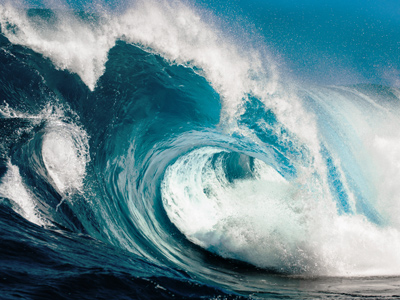This Science quiz is called 'The Moon and Tides' and it has been written by teachers to help you if you are studying the subject at middle school. Playing educational quizzes is a fabulous way to learn if you are in the 6th, 7th or 8th grade - aged 11 to 14.
It costs only $19.50 per month to play this quiz and over 3,500 others that help you with your school work. You can subscribe on the page at Join Us
Because of its proximity to the Earth, a gravitational pull occurs between the Earth and the Moon. The Earth’s seasons do not affect the Moon’s gravitational pull.
What are tides? Tides are the periodic swelling, or rising, and falling of bodies of water on the Earth’s surface. Climate factors can affect the tides, as well as earthquakes. However, besides climate, the gravitational attraction that exists between the Earth and the Moon also greatly affect the rise and fall of water levels. As the Earth is rotating while the Moon orbits it, there are two high tides and two low tides each day.
TYPES OF TIDES
Spring Tides: The strongest gravitational forces occur when the Moon and the Sun are aligned. The gravitational pull causes the water levels to be either extremely high or extremely low. When the water levels are extremely high or extremely low, they are known as Spring Tides. Spring Tides occur during the New Moon and the Full Moon.
Neap Tides: When the Moon and the Sun are not aligned, the gravitational pull is much weaker. This causes the level of the high and low tides to be far less severe in nature. These types of tides are then known as Neap Tides. Neap Tides occur during the 1st Quarter Moon and the 3rd Quarter Moon.
Proxigean Spring Tides: This type of tide is rare and occurs only once every one and a half years. The tide’s high level is extremely high and occurs when the Moon is closest to the Earth and in the New Moon phase.
Sun Tides: The Moon is not the only heavenly body that affects the Earth’s tides. The Sun also affects the tide although its gravitational pull has a lesser effect. In fact, the Sun’s gravitational pull has more of an effect upon the Moon which, in turn affects the Earth. If the Moon were to be destroyed, the Earth’s bodies of water would still experience tides but at much lower levels as the Sun’s gravitation is weaker.
The Moon rotates around the Earth at 12° a day which is equal to one rotation a month. Because of this rotation, it actually takes 24 hours and 50 minutes for the Moon to return to its beginning point in relation to the Earth. The tidal cycle, therefore, runs every 24 hours and 50 minutes.








